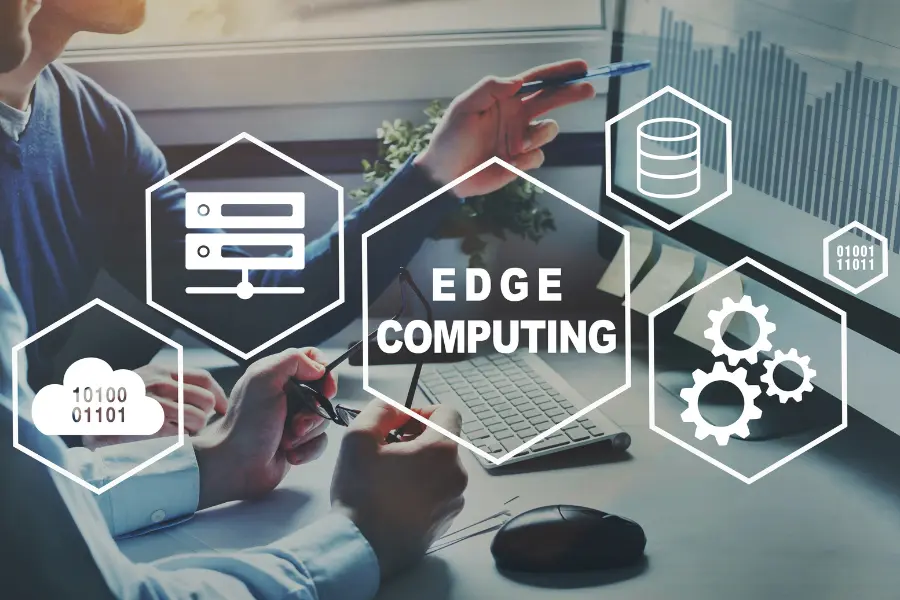Explore the Use of Python in Developing IoT Edge Computing Architectures
Python has become instrumental in developing robust and efficient IoT edge computing architectures. Edge computing refers to the practice of processing data closer to where it is generated, typically on IoT devices or local gateways, rather than in centralised data centres. Python's versatility, extensive library support, and ease of integration make it well-suited for implementing edge computing solutions that require real-time data processing, low latency, and scalability.

Aspects of Python in IoT Edge Computing
1. Data Processing and Analysis
Real-time data Processing and analysis at the Edge can be done with the rich ecosystem of Python libraries, like pandas, NumPy, and TensorFlow. Developers can assess and derive insights for action and decision-making on IoT devices or local gateways. They can analyze real-time sensor data and perform predictive analytics on the data derived.
2. Machine Learning and AI
Edge computing uses machine learning and AI applications structured by Python frameworks like sci-kit-learn, PyTorch, and TensorFlow. Developers need not rely on cloud services to deploy and execute machine learning models locally.
3. Edge Device Communication
Python's lightweight footprint and support for communication protocols (e.g., MQTT, CoAP, HTTP) make it ideal for establishing reliable communication between edge devices and central systems or cloud platforms. Libraries like paho-mqtt simplify the implementation of secure and efficient messaging protocols.
4. Edge Device Management Solutions
You can operate Edge devices from remote locations using Python frameworks like Flask or Django. You can monitor health devices, deploy updates to existing networks, and manage configurations from centralized management consoles or cloud platforms through APIs and web services.
5. Edge Analytics for IoT and Real-Time Decision-Making
Edge devices make autonomous decisions through real-time analytics based on incoming data streams. IoT devices and edge applications respond immediately to instructions or signals from sensors. Devices have asynchronous programming (e.g., with asyncio)from Python that aids in making instant decisions. Asynchronous programming is part of large-scale applications like industrial automation or Smart city deployments.
Implementing IoT Edge Computing with Python
- Edge Device Software Development: Python scripts can be deployed directly on edge devices, such as Raspberry Pi or industrial gateways, to handle data collection, preprocessing, and local analytics.
- Integration with Cloud Services: Python-based edge computing solutions can integrate seamlessly with cloud platforms (e.g., AWS IoT, Azure IoT Hub) for hybrid cloud-edge deployments. Python SDKs provided by cloud providers facilitate secure data exchange and synchronisation between edge and cloud environments.
- Federated Learning and Edge AI: Python frameworks like PySyft enable federated learning scenarios where machine learning models are trained collaboratively across multiple edge devices without sharing raw data. This approach enhances data privacy and reduces bandwidth consumption in IoT deployments.
- Edge Security and Privacy: Python's cryptography libraries (cryptography, pycryptodome) support data encryption and secure communication protocols, ensuring data confidentiality and integrity in edge computing architectures. Integration with Blockchain can further enhance security by providing immutable data logging and decentralised trust mechanisms.
Real-World Applications
- Smart Manufacturing:s Python-based edge computing optimises production processes by enabling predictive maintenance, quality control, and real-time monitoring of industrial equipment.
- Smart Agriculture: Edge computing with Python facilitates precision farming techniques by analysing sensor data to optimise irrigation, monitor crop health, and manage livestock conditions locally.
- Healthcare IoT: Python enables edge devices to process and analyse medical sensor data for real-time patient monitoring, diagnostic support, and personalised healthcare delivery.
Challenges and Considerations
- Resource Constraints: Edge devices often have limited computational power and memory, requiring optimization of Python code for efficiency and minimal resource consumption.
- Data Synchronisation: Ensuring consistency between edge devices and cloud platforms while minimising latency and bandwidth usage poses challenges in hybrid edge-cloud architectures.
- Security and Compliance: Edge computing solutions must adhere to data protection regulations (e.g., GDPR, HIPAA) and implement robust security measures to protect sensitive data stored and processed at the edge.
Conclusion
Python is a versatile tool for IoT edge computing architecture. It enhances operational efficiency, real-time data processing, and intelligent decision-making. Python leverages capabilities in data analytics, machine learning, communication, and security that allow developers to build resilient edge-computing solutions IoT needs in its evolution.
Active Events
From Zero to Hero: The Untold Secrets of Becoming a Full Stack Developer
Date: Aug 06, 2025 | 7:00 PM(IST)
7:00 PM(IST) - 8:10 PM(IST)
2749 people have registered
Navigating the World of SERP Features: Tips, Tricks, and Strategies
Date: Aug 07, 2025 | 7:00 PM(IST)
7:00 PM(IST) - 8:10 PM(IST)
2811 people have registered
Best Tips to Create a Job-Ready Data Science Portfolio
Date: Aug 06, 2025 | 7:00 PM(IST)
7:00 PM(IST) - 8:10 PM(IST)
2811 people have registered
Bootcamps
Data Science Bootcamp
- Duration:8 weeks
- Start Date:October 5, 2024
Full Stack Software Development Bootcamp
- Duration:8 weeks
- Start Date:October 5, 2024
